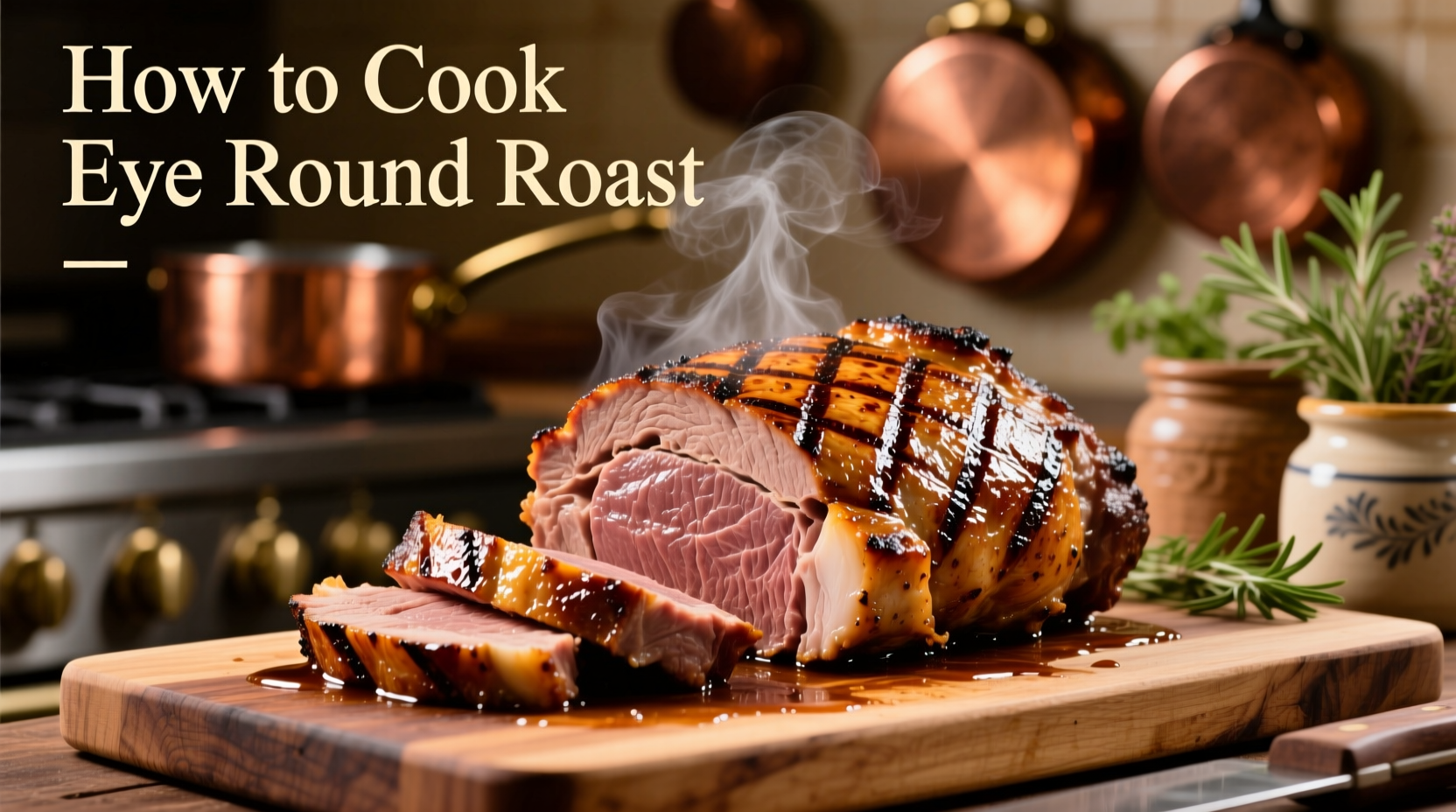Eye round roast often gets a bad reputation for being tough, but with the right technique, you can transform this affordable cut into a tender, flavorful centerpiece for your dinner. As a chef who's worked with hundreds of home cooks struggling with this cut, I've perfected a method that guarantees success every time.
Why Eye Round Roast Needs Special Attention
This lean cut from the rear leg muscle has minimal marbling and connective tissue, making it prone to drying out. Unlike chuck or brisket, eye round lacks the fat content that naturally bastes the meat during cooking. The American Meat Science Association confirms that "eye of round contains only 4.5g of fat per 3-ounce serving," explaining why traditional high-heat roasting often fails with this cut.

The Science Behind Tenderizing Eye Round
Understanding protein denaturation is key to perfect eye round roast. When muscle fibers heat past 140°F (60°C), they contract and squeeze out moisture. By cooking slowly at lower temperatures, you allow collagen to gradually convert to gelatin without excessive moisture loss. The USDA Food Safety and Inspection Service recommends 145°F (63°C) as the safe minimum internal temperature for beef, but pulling it at 130-135°F accounts for carryover cooking.
Essential Tools for Success
- Digital meat thermometer (critical for accuracy)
- Heavy roasting pan with rack
- Sharp carving knife
- Aluminum foil for resting
Step-by-Step Cooking Process
Preparation Phase (30 minutes)
Begin by trimming excess fat from your 2-3 pound roast. Create a simple dry rub using 2 tablespoons kosher salt, 1 tablespoon black pepper, 1 teaspoon garlic powder, and 1 teaspoon dried rosemary. Massage the mixture evenly over the entire surface. For deeper flavor penetration, refrigerate uncovered for 12-24 hours before cooking - this dry-brine technique helps the meat retain moisture during roasting.
Cooking Phase (2-3 hours)
Preheat your oven to 275°F (135°C). Place the roast on a rack in your roasting pan, fat-side up. Insert your thermometer into the thickest part, avoiding bone or fat pockets. Roast until the internal temperature reaches 130-135°F (54-57°C). This typically takes 15-20 minutes per pound. Resist the urge to open the oven frequently - each peek adds 5-10 minutes to cooking time.
| Roast Weight | Approximate Cooking Time | Target Internal Temp |
|---|---|---|
| 2 pounds | 45-60 minutes | 130-135°F |
| 3 pounds | 60-90 minutes | 130-135°F |
| 4 pounds | 90-120 minutes | 130-135°F |
Resting Phase (20 minutes minimum)
This is the most crucial step many home cooks skip. Transfer the roast to a cutting board, tent loosely with foil, and let it rest for at least 20 minutes. During this time, the internal temperature will rise 5-10 degrees (carryover cooking), and the muscle fibers will relax, redistributing juices throughout the meat. Cutting too soon releases precious moisture onto your cutting board.
Slicing Technique (Often Overlooked)
Always slice against the grain at a 45-degree angle using a sharp knife. Eye round has long muscle fibers running lengthwise - slicing across them shortens these fibers, making each bite more tender. Aim for 1/4-inch thick slices for optimal texture.
Troubleshooting Common Issues
Dry roast: You likely cooked at too high a temperature or didn't rest properly. Next time, reduce oven temperature to 250°F and extend resting time to 30 minutes.
Tough texture: This usually means insufficient resting or slicing with (not against) the grain. Always verify your slicing direction before cutting.
Bland flavor: Try a wet marinade with acid (like vinegar or wine) for 8-12 hours before cooking. The acid helps break down tough fibers while adding flavor.
When This Method Works Best (and Limitations)
This slow-roasting technique works perfectly for standard 2-4 pound roasts. However, for larger 5+ pound roasts, consider the reverse sear method: cook at 225°F until 115°F internally, then finish with a high-heat sear. Eye round roast shouldn't be used for traditional pot roast applications - its lean nature makes it unsuitable for long braising without drying out. For weeknight meals, slice leftovers thin and use in sandwiches or stir-fries where the tenderized texture shines.
Serving and Storage Tips
Serve with robust sides that complement the mild beef flavor: roasted root vegetables, garlic mashed potatoes, or a peppercorn cream sauce. Store leftovers in an airtight container with some pan juices for up to 4 days. When reheating, place slices in a covered dish with broth and warm gently at 250°F to prevent further moisture loss.
How long should I cook a 3-pound eye round roast?
A 3-pound eye round roast needs approximately 60-90 minutes at 275°F to reach 130-135°F internal temperature. Always use a meat thermometer rather than timing alone, as oven temperatures vary.
Can I cook eye round roast in a slow cooker?
Yes, but with modifications. Sear first, then cook on LOW for 6-8 hours with 1 cup of liquid. However, slow cookers often make eye round too stringy. The oven method produces more consistent results for this particular cut.
Why is my eye round roast still tough after cooking?
This usually happens when you slice with the grain instead of against it, or when you don't rest the meat properly. Ensure you're cutting perpendicular to the muscle fibers and allowing at least 20 minutes resting time before slicing.
What's the best internal temperature for medium-rare eye round roast?
Pull the roast at 130-135°F (54-57°C), then let it rest. The final temperature will reach 135-140°F (57-60°C), which is perfect medium-rare. Going beyond 140°F risks toughness in this lean cut.











 浙公网安备
33010002000092号
浙公网安备
33010002000092号 浙B2-20120091-4
浙B2-20120091-4